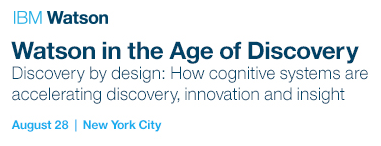IBM's Watson: Can it improve returns on R&D?

IBM on Thursday will outline a new advance in its Watson cognitive computing system that could ultimately help the returns on research and development.
At an event in New York, IBM will show off new uses for Watson as it aims to commercialize cognitive computing and make its Watson Group a growth driver. IBM launched its Watson Group in January and invested $1 billion into the effort.

To date, IBM has been deploying Watson in key verticals such as healthcare and life sciences and delivering its Watson Discovery Advisor as a cloud service. The catch is that Watson has to be prepped properly before deployed as a service. The system has to train itself as it ingests content that an IBM client wants.
You can see where IBM is headed with its commercialization moves. First, Watson finds a complicated vertical such as life sciences, pharma or healthcare. By co-innovating with customers, IBM can learn and scale Watson. By tackling industries one at a time, the Watson group ultimately expands.
Cognitive computing's use case has largely revolved around savings. For instance, a life saved with better care, more efficient call centers and the like. With Thursday's event, IBM will introduce Watson as a scientist's assistant. In a research context, the Watson Discovery Advisor digests data points from various scientific papers to make connections between chemistry, biology and intellectual property.
Strategy& estimates that the top 1,000 R&D companies spent $600 billion on research alone in 2013. If Watson could speed up the research portion, companies could spend more time and money on development. For instance, the Baylor College of Medicine found that Watson ran an automated analysis on proteins that modify p53, which is related to cancers. Watson analyzed 70,000 scientific articles on p53 to predict proteins that turn on or off p53's activity.
Similar efforts are underway at Johnson & Johnson. Steve Gold, vice president of the Watson Group, said that one goal of Thursday's powwow is to show off Watson's ability to impact other industries. Watson is capable of creating new food recipes, creating new financial analysis, conducting legal due diligence and helping governments better analyze security threats.
"Scientific discovery takes us to a different level as a learning system," said Gold. "Watson can provide insights into the information independent of the question. The ability to connect the dots opens up a new world of possibilities."
Implementing Watson
According to IBM, the Watson Discovery Advisor is available today as a cloud service. That statement implies you can find pricing and use Watson in the cloud easily. But there's some work to do.
Today, Watson's discovery engine has largely been used in pilots. If an enterprise wanted to use Watson it would have to do the following:
- Contact IBM.
- IBM and the customer would go through the use case for Watson.
- The content universe would have to be defined, say 70,000 scientific papers.
- Watson would have to "pre-ingest content" and be prepared for use.
- Watson would learn and ultimately yield insights.
- Cloud pricing isn't published, but the Watson Discovery Advisor is subscription based, but details depend on the use case, content ingested and other variables.
Given those moving parts, it's obvious why healthcare and scientific research is a core area for Watson. Watson could scale and be reuse the knowledge. Gold noted that a healthcare organization could choose to limit content to Pubmed or Medline and look to narrow searches to Parkinson’s Disease.
A law enforcement use case could also reuse data and knowledge. Watson could digest psychographic profiles and be used by retailers and advertisers. Gold said there's already a pilot seeing what Watson can do on the psychographic front to highlight interesting relationships between individuals and behavior.
IBM's challenge: Give Watson enough content and knowledge for more scalable use cases in industries and make implementations more turnkey.
The ROI on R&D
The biggest takeaway from Thursday's Watson update is that IBM could drive returns on R&D, a big expense that ranges anywhere from 3 percent of revenue to the mid-teens percent or more in the technology sector. IBM spends 6 percent of revenue annually on R&D.
If Watson could speed up the 8.5 years on average it takes a drug treatment to hit the market or highlight dead ends earlier, there are real returns to be had.
R&D returns would be transformative and a better narrative to tell instead of better call center handling.
Gold noted that IBM is spending one third of its R&D on cognitive computing. The best Watson return on investment story would be if Watson was able to save---or even fund---its own R&D. Gold said Watson has "indirectly" changed the way IBM does R&D. If IBM wants enterprises to flock to Watson en masse it should use its own R&D unit as a case study so it could cut spending to 5 percent of sales and be as efficient.
That 1 percent on $100 billion of sales annually would mean that Watson repaid IBM's initial investment in the Watson Group. It's nice that Watson can cook up recipes, but every enterprise on the planet would notice the promise of cognitive computing with better R&D.
More: Will Apple bring developers to IBM's Watson ecosystem? | IBM courts mobile developers for Watson platform | IBM's Watson unit invests in Fluid, eyes personal shopping applications | IBM Watson heads to Africa with $100m investment | IBM CEO Rometty: Watson, cognitive computing mainstreaming begins | IBM forms Watson Business Group: Will commercialization follow?